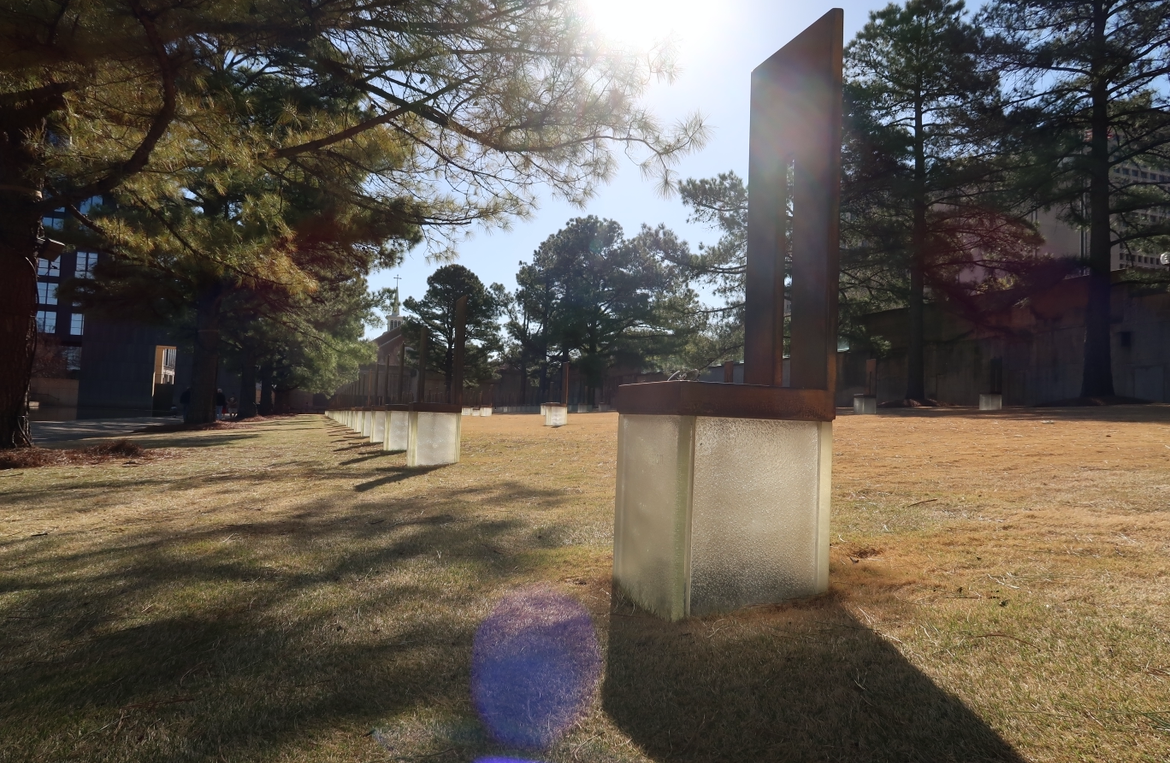Honoring Oklahoma City 30 years later
By Reagan Rozzi
Photo of memorial entry taken by Reagan Rozzi
April 19th, 1995, Oklahoma experienced America’s deadliest act of domestic terrorism in the nation’s history. 30 years later, we remember the day just as viscerally. The bombing of the Alfred P. Murrah building in downtown Oklahoma City killed 168 people, including 19 children. The magnitude of the tragedy still connects individuals across the nation—even those 122 miles away in Owasso, Oklahoma.
Madame Sarah Butterworth, the Owasso High School and Eighth Grade Center’s French teacher, was in ninth grade at Midwest City High School during the time of the attack, only seven and a half miles away from the Murrah building.
Butterworth remembers, “[The school] had [their] windows open because it was a gorgeous day. … It sounded like a giant was shaking a dumpster with bowling balls in it. Like, it was very metallic. It was very resonant, like, you could hear the vibration. We could feel the vibration.”
Butterworth and her classmates first believed it was the baseball team amping up for their big game later that day, banging their bats against any object that would cause a ruckus. The students were oblivious to the horrors only a few miles away. Three minutes after Butterworth investigated the commotion—with nothing to be found—administration announced over the speakers that all teachers were to keep their televisions off and to await further instructions.
During the following class period, Butterworth’s friend had arrived past the tardy bell. It was then that the friend showed Butterworth her office note and shared the reality of the bombing downtown. The friend’s knowledge came from her mother, nurse and first responder Rebecca Needham Anderson, who had called the school to inform the friend and her brother.
“All [she knew] was that it was really bad and they [were] literally calling every first responder in the metro area to come help,” Butterworth shares.
The next day, Butterworth’s friend wasn’t in class. Butterworth discovered later that Rebecca Needham Anderson had been killed by fallen debris during clean-up. She was the only person who died that was not in the building at the time of the bombing.
Butterworth began to tear up.
“The fact that [her daughter] was the one that told me what happened … and the reason that she told me was because her mom called to tell her that her brother was picking her up and that she was going to help. And then literally that day, got hit by some chunks of concrete that broke loose from the building.”
Photo of Rebecca Needham Anderson’s chair taken by Reagan Rozzi
Butterworth further described the trauma and how close to home the tragedy was, sharing how it seemed that “everybody knew somebody who had family there.” Even 30 years after the occurrence, she still struggles with the harsh reality of such cruel circumstances.
In discussing the architectural tribute that is the bombing’s memorial, she softly shares, “It’s hard. I mean, it’s a really, really hard place to go to when you live through something like that.”
Butterworth makes it a point to share her story with each year’s incoming class in the hopes that she can connect with those who might have shared a similar experience and raise awareness about a historical event that could otherwise easily be looked over.
Photo of flower memorial taken by Reagan Rozzi
Judge Daman Cantrell of Owasso High School’s mock trial team had moved to Tulsa in early 1995, missing the bombing by roughly four months.
“I had just been working for their federal judge across the street from the Murrah building. … I would go there all the time for various [reasons],” Cantrell recalls. He shared that his kids even used to attend the building’s daycare.
While his family was one of the lucky ones to physically miss the explosion, he still knew several victims through his work connections.
“I got to know … Ann Doman and [she] was actually in the building that blew up and was a survivor.”
Another court administrator from Cantrell’s current courthouse was a survivor, as well as one of the law clerks, who actually entered the building during its fiery burnout to find his child in the remnants of the daycare.
“My wife and I count our blessings and think, you know, maybe barely five months before [the bombing] our daughters were in that daycare.”
Cantrell noted during the interview that his story does not compare to that of those who survived or the families who lost their loved ones. Yet still, the situation has taught him and his family the importance of perspective and sharing stories with their community.
While the heartbreaking events of that early April morning should have never occurred to begin with, the way in which we choose to honor both the lost and living continues to bring these moments to light. Butterworth and Cantrell’s stories display that there is a community to be found within tragedies such as these.
Photo of memorial exit taken by Reagan Rozzi









